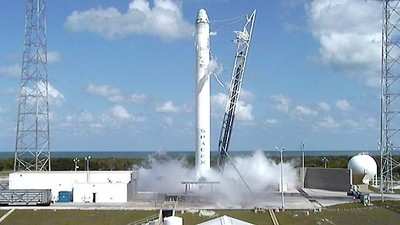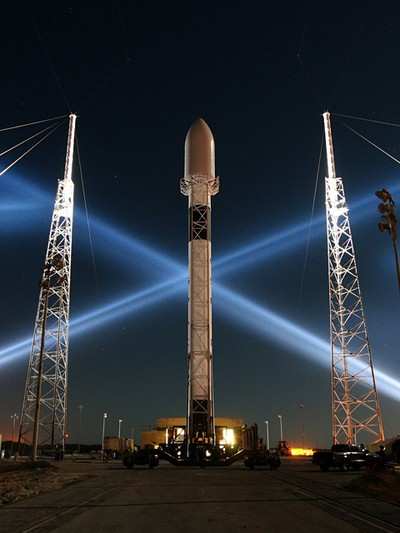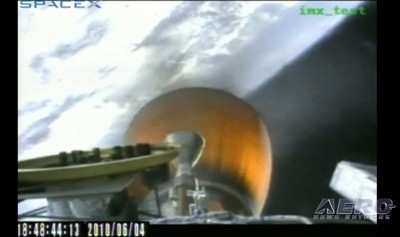Tue, Dec 07, 2010
Falcon 9 Launch Attempt Now Scheduled for Wednesday
Morning
ANN Update 12.07.2010 2016 EST: NASA announced
late Tuesday that the first demonstration flight of SpaceX's Falcon
9 rocket and Dragon capsule for NASA's Commercial Orbital
Transportation Services program has been scheduled for Wednesday,
Dec. 8, from Cape Canaveral Air Force Station in Florida. The
launch window extends from 0900 to 1222 EST.
During a routine inspection this week, SpaceX engineers observed
two small cracks in the rocket's second stage engine nozzle. SpaceX
completed repairs to the cracked nozzle Tuesday.
Original Story: News and Analysis by Wes Oleszewski
Tuesday's planned launching of SpaceX's second Falcon 9 rocket
was scrubbed early Monday. The reason for the scrub was that
engineers discovered two small cracks in the aft end of the 2nd
stage engine nozzle expansion.

The expansion nozzle on the second stage's Merlin engine is made
of a niobium alloy and is used to enhance performance in the vacuum
of space. That enhancement was designed to allow the launch vehicle
to reach the International Space Station (ISS) or to loft heavy
payloads and deep-space vehicles. Since this mission of the Falcon
9 is intended to place the Dragon spacecraft into a simple low
earth orbit that is of a far lower incline that that of the ISS,
the enhancement value of the nozzle is not required. Speculation,
independent of SpaceX, is that if the nozzle extension were to
further fracture after stage separation there would be little
impact on the overall mission.

Although the nozzle extension is nine feet tall and has a base
diameter of eight feet its average wall thickness is less than 1/3
of a millimeter, or slightly thicker than the wall of a soda pop
can. Technicians will be able to use small grinding and cutting
tools to cut away and smooth the damaged areas. The real question
being if the cracks are part of a local anomaly or if they
represent a larger problem.

SpaceX, as of this writing, has elected to announce a final
launch decision on Tuesday evening after greater study of the
issue. If officials are satisfied with the the fixes the Falcon 9
could make a launch attempt as early as Wednesday.
More News
Aero Linx: Aviators Code Initiative (ACI) Innovative tools advancing aviation safety and offering a vision of excellence for aviators. The ACI materials are for use by aviation pra>[...]
Make Sure You NEVER Miss A New Story From Aero-News Network Do you ever feel like you never see posts from a certain person or page on Facebook or Instagram? Here’s how you c>[...]
From 2016 (YouTube Edition): Who You Gonna Call When You Have a Rocket Engine that Needs a Spacecraft? While at EAA AirVenture 2016, ANN CEO and Editor-In-Chief, Jim Campbell, sat >[...]
"In my opinion, if this isn't an excessive fine, I don't know what is... The odds are good that we're gonna be seeking review in the United States Supreme Court. So we gotta muster>[...]
Expedite Used by ATC when prompt compliance is required to avoid the development of an imminent situation. Expedite climb/descent normally indicates to a pilot that the approximate>[...]
 ANN's Daily Aero-Linx (04.30.25)
ANN's Daily Aero-Linx (04.30.25) ANN FAQ: Turn On Post Notifications
ANN FAQ: Turn On Post Notifications Classic Aero-TV: Agile Aeros Jeff Greason--Disruptive Aerospace Innovations
Classic Aero-TV: Agile Aeros Jeff Greason--Disruptive Aerospace Innovations Aero-News: Quote of the Day (04.30.25)
Aero-News: Quote of the Day (04.30.25) ANN's Daily Aero-Term (04.30.25): Expedite
ANN's Daily Aero-Term (04.30.25): Expedite





